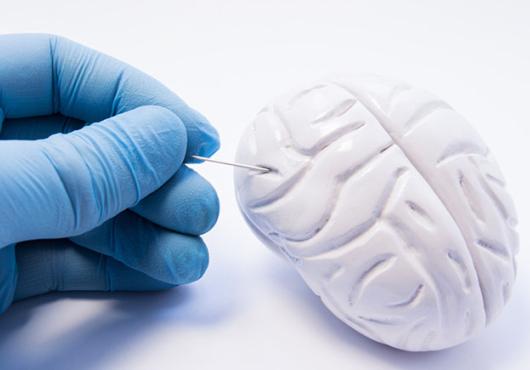
In the quest for new cancer therapies, microRNAs—tiny strings of nucleotides churned out inside cells—have been a source of both excitement and disappointment.
While preclinical studies have found that microRNAs play an important role in cancer and other diseases, two clinical trials using microRNAs showed little response and significant toxicity.
Now, a team of investigators at Harvard Medical School and Brigham and Women’s Hospital has begun looking at these molecules in an entirely new way. Rather than modulating just one at a time, they grouped multiple micro RNAs that naturally occur in the brain into a small artificial gene. They then used the microRNA-loaded gene to co-opt cancer cells’ molecular machinery, coaxing it to overproduce microRNA molecules and in so doing, weaken the cancer cells.
The team’s approach has shown promising results in preclinical models. Combined with standard chemotherapy, it increased survival fivefold in a mouse model of glioblastoma, one of the deadliest and hardest to treat brain tumors.
A description of the team’s work was published Jan. 25 in Nature Communications.
“I like to think of it as hitchhiking,” said corresponding author PierPaolo Peruzzi, HMS assistant professor of neurosurgery andan attending clinical neurosurgeon in the Department of Neurosurgery at Brigham and Women’s. Peruzzi is also a principal investigator in the Harvey Cushing Neuro-Oncology Laboratories at Brigham and Women’s. “Cancer cells have a built-in system to produce and recognize microRNAs. We’re getting them to ‘pick up’ our sequence—which encodes multiple microRNAs—and start making more copies of them. The cellular machinery is running, and our sequence is along for the ride.”
Peruzzi and colleagues, including lead author Vivek Bhaskaran, a postdoctoral fellow in neurosurgery at HMS and Brigham and Women’s, set out to find groups of microRNAs responsible for regulating complex signaling pathways. Using bioinformatics analysis, the team focused on a group of three microRNAs—miR-124, miR-128 and miR-137—which work properly as a team in developing neurons but are silenced during the formation of brain cancer. Interestingly, the team found that several of these microRNAs regulate the very proteins that drive glioblastoma recurrence and this cancer’s resistance to conventional therapies.
The research team tested its findings using multiple cancer cell lines, including glioblastoma as well as nonglioblastoma cell lines. In addition, investigators tested the effectiveness of modulating all three microRNAs at once in a mouse model of intracranial tumors. The team observed a significant survival benefit. Without treatment, the mice survived 12 days after tumor onset. Chemotherapy extended this to a median of 18 days. But when the researchers gave animals the chemotherapy-multi-microRNA combo, they survived for a median of 48.5 days.
“These results are very encouraging and, if affirmed in subsequent studies, may provide a realistic treatment option,” said Bhaskaran.
Peruzzi noted that the multi-microRNA strategy weakens tumor cells but does not directly kill them.
“While it seems a bit counterintuitive, this is actually an advantage, since by remaining alive, although severely impaired, cancer cells continue to produce microRNAs, which eventually flood the entire tumor.”
Indeed, the authors observed that these artificial microRNAs spread into the tumor through tiny vesicles, leaving it more vulnerable to chemotherapy.
“We’re coaxing the tumor to produce its own poison, and then we hit it for good with chemotherapy or radiation,” said Peruzzi. “And we’re optimistic that in a relatively short time we can advance this approach to the clinic.”
A further refined and even more potent version of the concept is already in the pipeline, the scientists said.
Clinical trials underway at Brigham and Women’s are leveraging viral vectors and gene therapy approaches for treating primary and recurrent glioblastoma. Peruzzi and colleagues are working to further refine their microRNA approach with the goal of using viral vectors to deliver these microRNAs to tumors in patients with brain cancer.
Funding for this work was provided by the Neurosurgery Research Career Development Program and the National Institute of Neurological Disorders and Stroke (grants K12NS80223 and K08NS101091).
Adapted from a Brigham and Women’s news release.




